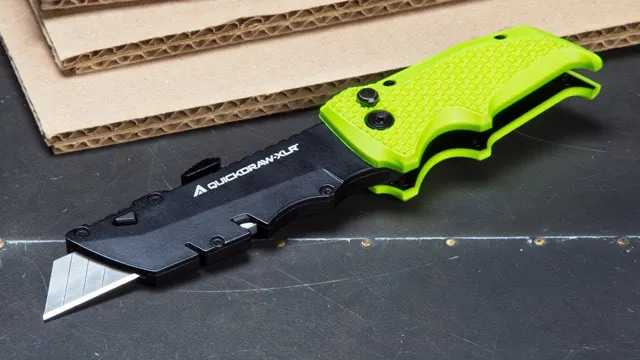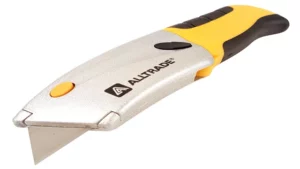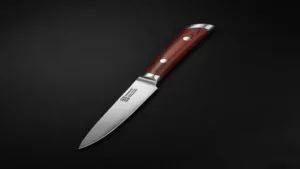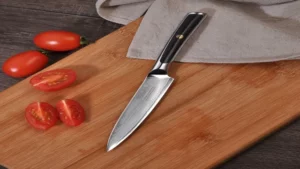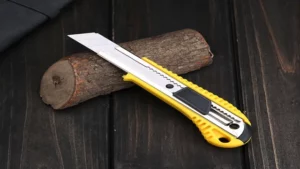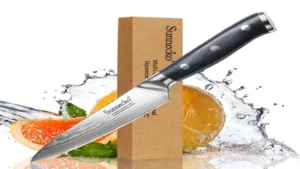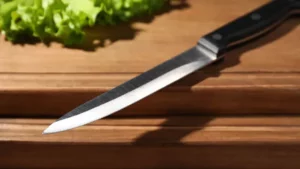Hey there, do you ever find yourself struggling to find the right tool for a specific task? Whether you’re working on a DIY project, cooking in the kitchen, or just need to make a quick cut, having the right tool makes all the difference. That’s where the versatile utility knife comes in – a handy tool for a wide range of tasks. Perfect for slicing, dicing, chopping, and more, this all-purpose knife is a must-have in any toolbox or kitchen drawer.
In this blog, we’ll explore the many uses of this versatile tool and how it can make your life easier in so many ways. So get ready to discover the many benefits of the utility knife and why it’s an essential tool for anyone looking to get things done.
What is a Utility Knife?
A utility knife, as the name suggests, is an all-purpose knife designed for a variety of everyday tasks. It is a versatile tool that is commonly used in a range of settings, such as kitchens, workshops, and outdoor activities. Utility knives tend to have a short blade that is sharp and pointed, with a comfortable handle that provides a secure grip.
This type of knife is used for slicing and cutting a variety of materials, including food, cardboard, plastic, leather, and wood. So, whether you’re opening a package, trimming cardboard, or slicing vegetables, a utility knife is a go-to tool for a wide range of cutting tasks. In summary, a utility knife is an essential item for anyone looking for a compact, versatile cutting tool that can tackle a variety of everyday jobs with ease.
A brief introduction to the utility knife and its origins
A utility knife, also known as a box cutter, is a versatile cutting tool that can be used for a variety of tasks. With its sharp, replaceable blade and retractable design, it is perfect for cutting cardboard, opening packages, and even removing wallpaper. The origins of the utility knife can be traced back to the 1920s when it was first developed as a tool for use in industrial settings.
Since then, it has become a staple in many households and workplaces due to its practicality and ease of use. Whether you are an avid DIY enthusiast or need a reliable tool for everyday tasks, a utility knife is a must-have in any tool kit.
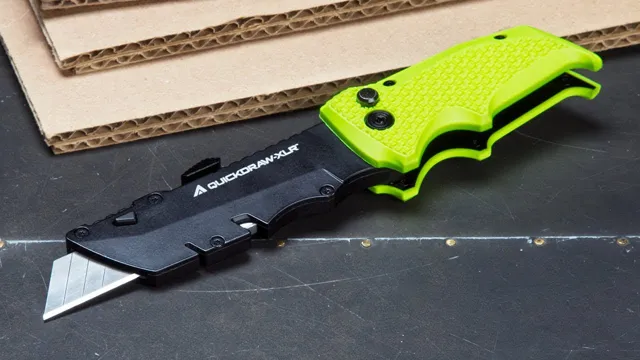
Different Types of Utility Knives
Utility knives are an essential tool that serve a variety of purposes in day-to-day life. While they may seem like a basic tool, there are actually various types of utility knives that can be used for different tasks. One common type is the retractable utility knife, which is a multi-purpose tool that can be used for cutting open boxes and packages, slicing through cardboard, and even for trimming carpet or other materials.
There’s also a folding utility knife, which is commonly used by hunters and outdoors enthusiasts on camping trips or expeditions. It folds compactly, making it easy to carry and store, and has a retractable blade that can be replaced or sharpened as needed. Additionally, there’s the serrated utility knife, which is designed specifically for slicing through tough materials like rope, leather, or rubber.
So whether you’re an outdoorsman or simply need a blade for everyday tasks around the house, there’s a utility knife that will fit your needs.
Breaking down the different types of utility knives and their applications
Utility knives come in a variety of forms, each with its own set of unique applications. Firstly, there is the traditional utility knife that you would find in most households, with a simple retractable blade for cutting open boxes or packaging. Then, there are serrated utility knives, which feature a toothed edge that is ideal for slicing through tougher materials like thick paper or dense cardboard.
For those working in construction or carpentry, there are heavy-duty utility knives with thicker, sturdier blades that can withstand more significant pressure and force. Finally, there are multi-purpose utility knives, which often have interchangeable blades for different cutting purposes. These knives are perfect for those who require a variety of cutting tools for various tasks.
Regardless of your needs, there is certainly a utility knife that will suit your specific requirements.
Fixed Blade Utility Knives
Fixed Blade Utility Knives There is a wide range of fixed blade utility knives available out there, each having its own set of features and uses. However, two main types of utility knives are commonly used, and knowing their differences will help you pick the one that fits your needs best. The first one is known as the general-purpose knife and is designed for light to medium-duty tasks.
This type of utility knife typically has a blade length of around 3 to 4 inches, making it perfect for everyday tasks such as opening packages and cutting through cardboard boxes. On the other hand, the heavy-duty or contractor’s utility knife has a thicker and longer blade, ranging from 5 to 7 inches. This type of knife is ideal for more demanding tasks like cutting through thicker materials like cable insulation or drywall.
Whatever your needs may be, choosing the right utility knife can make all the difference in getting the job done efficiently and safely.
Retractable Blade Utility Knives
Retractable Blade Utility Knives Utility knives are versatile tools that can be used for a wide range of purposes, from cutting boxes to slicing food items. One of the most popular types of utility knives is the retractable blade utility knife, which is designed to provide a safe and comfortable cutting experience. These knives have a retractable blade, which means that the blade can be extended and retracted as needed.
There are different types of retractable blade utility knives available in the market, including fixed and folding blade models. Fixed blade utility knives have a blade that cannot be folded into the handle, while folding blade models allow the blade to be folded and stored within the handle. Some types of utility knives also have replaceable blades, which can be easily swapped out when they become dull or damaged.
When shopping for a utility knife, it’s important to consider the type of blade, handle design, and overall durability to ensure that you choose a tool that will meet your needs and last for years to come.
Uses for a Utility Knife
A utility knife is a versatile tool that can be used for a wide range of tasks in both professional and personal settings. One of the most common uses for a utility knife is for cutting through various materials, such as cardboard, leather, and plastic. It can also be used for opening packages, trimming down wallpaper, and scoring drywall.
In addition, a utility knife can come in handy for more precision work, such as carving or sculpting. This tool is lightweight, portable, and easy to handle, making it an essential item in any tool kit. So, whether you are a craftsman, DIY enthusiast, or simply need a reliable cutting tool, a utility knife is a great investment that can save you time and effort in completing your projects.
Cutting through different materials
A utility knife is a versatile tool that has many uses around the home, on the job site, or in the great outdoors. One of the most useful functions of a utility knife is cutting through different materials. Whether you need to cut through cardboard, rope, carpet, or even plastic, a utility knife can make short work of the job.
The sharp blade of a utility knife can easily slice through these materials, making it a great tool for DIY projects, crafting, or moving tasks. Plus, a utility knife is portable and lightweight, making it easy to carry with you wherever you go. So next time you need to cut through a tough material, reach for your trusty utility knife and get the job done quickly and efficiently.
Opening boxes and packages with ease
If you’re someone who frequently receives packages, a utility knife can be a game-changer. The sharp blade allows you to quickly open boxes with ease, without struggling to break through stubborn tape and cardboard. But the usefulness of a utility knife doesn’t stop at just opening packages.
It can also come in handy for a range of other tasks, such as trimming excess materials, cutting through plastic materials, and even scoring drywall. The versatility of a utility knife makes it a valuable tool to have in your toolbox or drawer. Plus, it’s small enough to carry around with you on-the-go, making it perfect for camping trips, DIY projects or any other situation where you may need to quickly cut through something.
So if you’re tired of struggling with packages, consider picking up a utility knife and making your life a whole lot easier.
Trimming and shaping materials like wood and drywall
Trimming and shaping materials like wood and drywall can be a daunting task if you don’t have the right tools. Luckily, a utility knife is a versatile tool that can be indispensable in these situations. Whether you’re cutting through thick pieces of wood or smoothing out rough edges on drywall, a utility knife can make the job much easier.
Some common uses for a utility knife include trimming excess material, cutting shapes and designs, and scoring lines for easy bending. With a sharp and sturdy blade, a utility knife can be used for precision cuts and intricate designs. So the next time you’re working on a DIY project, don’t forget to keep a trusty utility knife on hand.
It may just make all the difference!
Choosing the Right Utility Knife for Your Needs
When it comes to choosing a utility knife, it’s important to consider what the knife will be used for. Utility knives are versatile tools that can be used for a variety of tasks, from trimming cardboard boxes to slicing through meat. The most common utility knife blade is a retractable blade that can be adjusted to different lengths depending on the task at hand.
Other types of utility knives include fixed-blade knives and snap-off blade knives. When selecting a utility knife, it’s important to consider the handle material as well as the blade material. Handles can be made from a variety of materials, including plastic, wood, and metal.
Blades can be made from stainless steel, high carbon steel, or ceramic. The type of blade material you choose will depend on your specific needs and preferences. Overall, a utility knife is a handy tool to have in any toolbox or kitchen, and the right choice will depend on the user’s needs and preferences.
Factors to consider when choosing a utility knife
When it comes to kitchen knives, a utility knife is an essential tool that should not be overlooked. However, with so many different options available, choosing the perfect utility knife can be a daunting task. Firstly, consider the blade material, as this is the most important factor in determining the knife’s quality and durability.
Stainless steel is the most popular choice, as it is rust-resistant and easy to sharpen. Additionally, the size and shape of the blade should be taken into account. A longer blade provides a greater cutting surface and can be used for heavier tasks, while a shorter blade is more versatile and can be used for precision work.
Finally, the handle of the knife should be comfortable to hold and provide a secure grip. Look for a handle made from a durable but lightweight material, such as plastic or wood. By taking these factors into consideration, you can choose the right utility knife that will meet all of your needs in the kitchen.
Blade type and size
When it comes to choosing the right utility knife for your needs, one of the most important factors to consider is the blade type and size. There are several different types of blades to choose from, including straight, serrated, and curved. Straight blades are great for slicing through smooth surfaces, while serrated blades are better for cutting through tougher materials like bread or meat.
Curved blades are ideal for precision cutting and intricate tasks. In terms of size, smaller blades are more versatile and easier to control, while larger blades can handle tougher jobs with ease. Ultimately, the blade type and size you choose will depend on your specific needs and the tasks you plan to tackle with your utility knife.
It’s important to choose the right blade for the job to ensure the best results and avoid injuries.
Ergonomics and grip
When it comes to choosing the right utility knife for your needs, ergonomics and grip are a crucial factor to consider. After all, you’ll be using this tool frequently, and a poor grip or uncomfortable design could lead to hand fatigue, cramps, or even injury. Look for a knife with a handle that fits well in your hand and has enough texture or grip to prevent slipping.
You may also want to consider the knife’s weight and balance, as a knife that’s too heavy or off-balance can make it harder to use efficiently. Ultimately, when it comes to ergonomics and grip, it’s essential to choose a utility knife that feels comfortable and natural in your hand, allowing you to focus on your task at hand rather than your tool. So, take the time to try out different options and find the one that suits you best.
Safety features
When it comes to choosing a utility knife, safety features should be a top concern. Look for knives with locking mechanisms that prevent the blade from accidentally closing and causing injury. Many models also come with retractable blades that can be easily stored away when not in use.
Additionally, ergonomic handles can help prevent hand fatigue and provide better grip to reduce the risk of accidents. When working with utility knives, it’s important to always follow proper safety procedures, including using sharp blades and keeping fingers away from the cutting path. By taking the time to choose a utility knife with the right safety features, you can ensure a safer and more efficient work experience, whether in the workplace or at home.
Conclusion
In conclusion, a utility knife is a versatile tool that’s perfect for slicing through a variety of materials. Whether you’re opening boxes, trimming wallpaper, or sharpening pencils, a sharp utility knife is your go-to tool for precision cutting. So, if you need to tackle any task that requires finesse and accuracy, reach for a trusty utility knife and let it do the cutting-edge work for you!”
Wrapping up the versatility and usefulness of the utility knife
When it comes to choosing the right utility knife for your needs, there are several factors to consider. Firstly, what will you be using it for? Will you primarily be cutting through materials like cardboard and tape, or will you be using it for more heavy-duty tasks like cutting through plastic or even small branches? Once you determine your primary use, you can focus on the blade length and material. A longer blade may be necessary for larger materials, while a strong stainless steel blade will hold up against tougher materials and last longer.
Additionally, the handle is an important factor to consider. A comfortable grip is essential for avoiding hand fatigue during extended use. Finally, don’t forget about safety features like blade locks or retractable blades.
Choosing the right utility knife may take some research and consideration, but it’s an investment that will make your daily tasks easier and more efficient.
FAQs
What are the different types of utility knives?
The different types of utility knives include fixed blade, retractable blade, folding, snap-off blade, and serrated edge.
How do you use a utility knife safely?
To use a utility knife safely, always cut away from your body, ensure the blade is locked in place, and never leave it within reach of children.
Can utility knives be sharpened?
Yes, most utility knives can be sharpened using a sharpening stone or honing rod. It is important to follow the manufacturer’s instructions for proper sharpening.
What materials can be cut with a utility knife?
Utility knives can cut a variety of materials, including cardboard, fabrics, plastics, and thin metals.
What should you look for when buying a utility knife?
When buying a utility knife, look for features such as a comfortable grip, a durable blade, and a locking mechanism for safety.
How often should utility knife blades be changed?
Utility knife blades should be changed regularly, typically after 3-5 uses or once the blade becomes dull or damaged.
Are utility knives suitable for outdoor activities?
Yes, utility knives can be used for outdoor activities such as camping, fishing, and hiking due to their versatility and ease of use.
